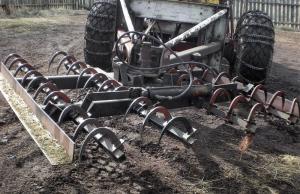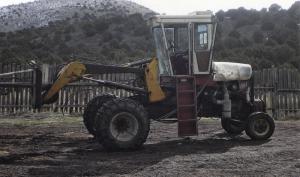2011 - Volume #35, Issue #4, Page #28
[ Sample Stories From This Issue | List of All Stories In This Issue | Print this story
| Read this issue]
Combine Converted To Front-End Loader
 |
 |
††††"I built it because I couldn't justify the cost of a new loader tractor," says Siddoway. "I used mostly salvaged materials to build it. My total cost was less than $2,000.
††††"I drop the bales on the ground behind the baler and later use a self-propelled New Holland bale wagon to pick them up and unload the bales in stacks. During the winter, I use the combine hay loader to load the bales from the stacks onto a truck - an old World War II 2 1/2-ton, 6-WD army truck Ż for feeding on pasture."
††††He got the combine from a neighbor and removed the threshing parts, leaving the engine, cab, transmission, and running gear intact. He used 8-in. channel iron to reinforce the combine's frame. Then he repositioned the cab and engine to make room for the bale fork. The cab, originally offset to the side, was remounted to the center of the machine. The engine, which originally sat on top of the combine along with the hydrostatic drive and hydraulic pump, was remounted on back.
††††Then he bought an old, heavy-duty front-end loader at a salvage yard and welded in new material to lengthen it by 2 ft., so that it would raise high enough to load bales onto trucks.
††††To build the bale fork he copied a commercial model but made it much heavier. "I'm in the repair business, and over the years I've had to fix way too many bale forks because they were built too light," says Siddoway. He used 4-in. steel tubing to build the shafts that support the teeth, which he bought from a New Holland dealer. The teeth are arranged in 4 rows and are spaced 1 ft. apart. ††††
††††The bale fork is attached to a large rectangular steel plate that pins onto the loader arms. By activating a hydraulic cylinder, the entire bale fork can be rotated 90 degrees to the left or right. Siddoway cut the track-rotating mechanism off an old World War II Japanese army tank and welded it to the center of the bale fork, where a hydraulic cylinder rotates the bale fork.
††††"I wanted a rotating bale fork because I stack bales on the truck lengthwise and crosswise in alternate layers," explains Siddoway. "With a conventional bale fork I would have to change directions with the loader. I can pick up a load of hay, back up to the truck, and then rotate the fork so I don't have to turn around all the time."
††††The bale fork's teeth are opened and closed by a single hydraulic cylinder. Another cylinder tilts the bale fork up or down, and another raises and lowers the loader.
††††He says the bale fork has twice as many teeth as most commercial models, "so it's sure to pick up all the bales. On most commercial bale forks, the teeth are spaced farther apart and don't always grab the bales securely."
††††The loader is raised and lowered by a pair of 4-in. hydraulic cylinders. "It's built much heavier than conventional loaders. After repairing a lot of loaders over the years I knew I wanted something heavy," says Siddoway.
††††The combine came equipped with diamond tread tires on front. "I like that the tires don't leave deep ruts in the ground. However, they also don't have much traction so I installed chains on the drive tires, which really help when it's wet," says Siddoway, who also added wheel weights on back of the rig and filled the tires with fluid.
††††Contact: FARM SHOW Followup, Val Siddoway, Falula Farms, Inc., P.O. Box 57, Laketown, Utah 84038 (ph 435 946-3321).

Click here to download page story appeared in.

Click here to read entire issue
To read the rest of this story, download this issue below or click here to register with your account number.




